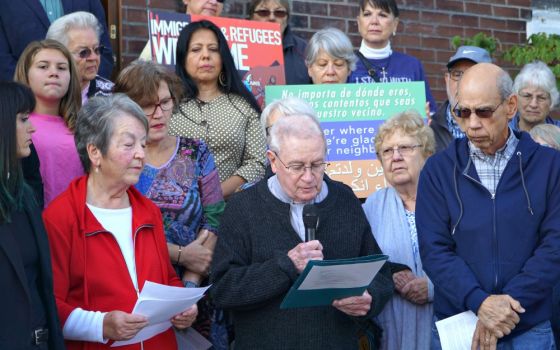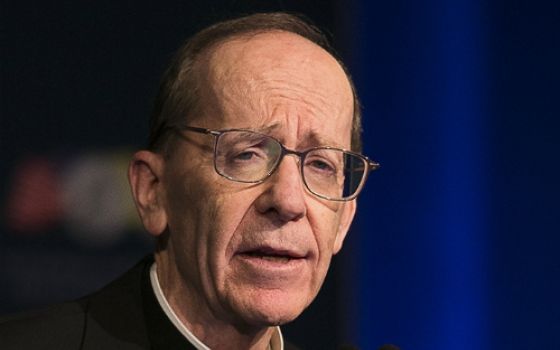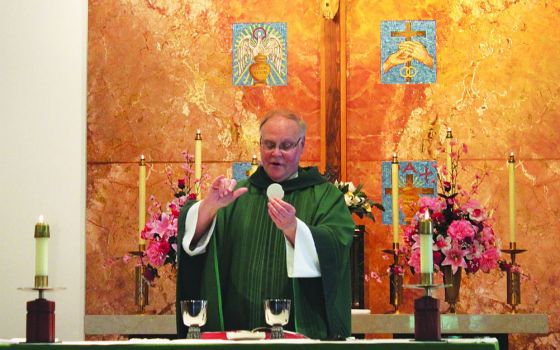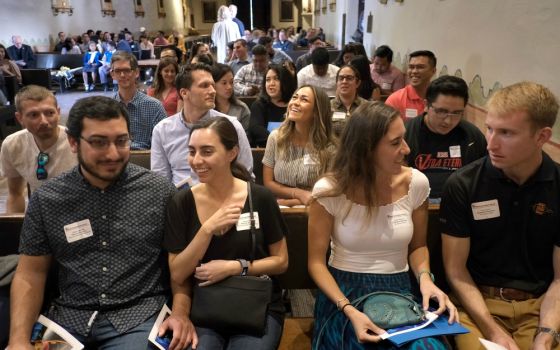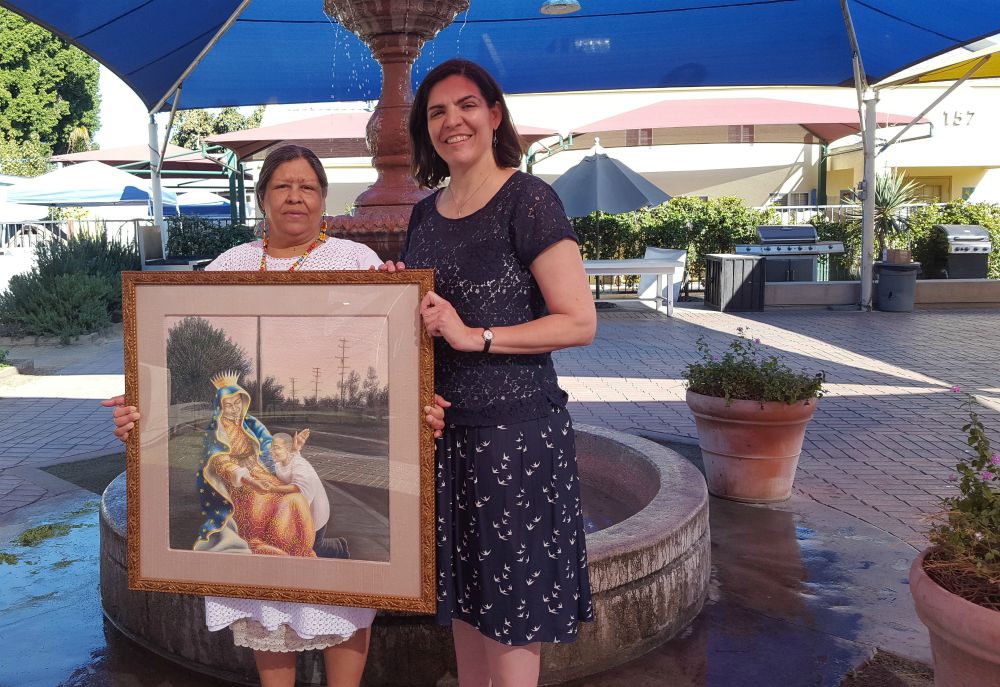
Long-time Dolores Mission parishioner Rita Chairez, left, works in restorative justice, investing much of her time visiting persons in prison. She is holding a color-pencil drawing by J. Michael Walker created to be used on promotional T-shirts for Homeboy Industries, the intervention and rehabilitation ministry to gangs which was founded in the parish three decades ago. Next to her is Dolores Mission Pastoral Associate Ellie Hidalgo. (Dan Morris-Young)
Some prisoners call her "brutal" because she asks the hard questions. At least one calls her "the surgeon" because "she breaks our hearts and then heals them back together." But most inmates she visits simply call her "Mama Rita."
Rita Chairez, 57, knows the hearts and minds of the incarcerated as well as anyone can. For six years she has worked with imprisoned adult men and women through the Los Angeles Archdiocese's Office of Restorative Justice and recently became program coordinator of Healing Hearts Restoring Hope, a non-profit providing support for persons impacted by homicide — victims, survivors and perpetrators.
Prior to that she fostered support groups at Dolores Mission Parish in East Los Angeles, primarily for women who had lost loved ones to violence.
Chairez also understands the hearts and minds of those impacted by violent crime. She herself lost two brothers to violence — Gustavo, 22, in 1990, and Roberto, 35, 10 years later.
That she works today with men and women who have committed heinous crimes still seems to surprise the mother of two and grandmother of one.
"It kind of crept into my heart," she told NCR.
She felt little but devastation at the death of Gustavo, she said, and could not fathom how her late mother came to forgive his killer.
"I could not understand how and why she could do that. I would say, 'How can you forgive? How can you go on knowing that someone took your son's life?' As a mother, I knew I would not be able to forgive."
"But, my mom did," Chairez continued. "She said she wanted her son to rest in peace." Her mother's resolve and example still inspire her.
During Roberto's devastating murder in 2000, Chairez said she found a path toward healing in small Ecclesial Base Communities at Dolores Mission where she has been deeply involved since 1989.
She clearly recalls the comfort and strength shared by a mother who had lost a daughter to street violence a month earlier.
"I was invited to heal," she said. "Healing came with being able to walk with the community, in knowing and sharing their lives."
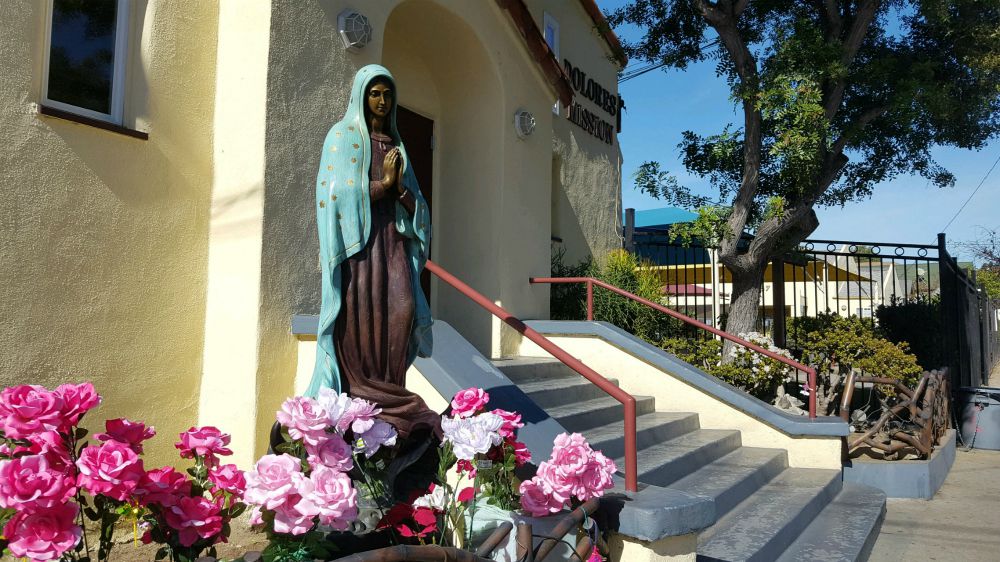
The statue of Our Lady of Guadalupe outside of Dolores Mission Church was donated by actor Martin Sheen, who was a friend of former pastor Fr. Mike Kennedy, who served 1994-2007. (NCR photo/Dan Morris-Young)
She also credits three priests for coaxing her toward ministry in jails and prisons — two now-former Dolores Mission pastors, Jesuits Fr. Greg Boyle and Fr. Scott Santarosa, and Fr. George Horan, an archdiocesan priest who then headed the archdiocese's Office of Restorative Justice and who founded Healing Hearts Restoring Hope in 2014.
Boyle, she said, in homilies "invited all to the table" and encouraged by example how to see others in new ways. Boyle is well-known as the founder of Homeboy Industries, the prominent intervention and rehabilitation ministry to gangs. Santarosa — who now heads the Jesuits' West Province — told her "to follow my heart." Horan, she added, repeatedly encouraged her to join him in restorative justice ministry.
"I did not think I even knew what it was," she said. "But Fr. Horan said I was already doing it" in her ministry for families who had lost loved ones.
A turning point came, she said, when she and her mother attended a Mass for surviving families and friends of lost loved ones. Horan was celebrant.
"At first it just opened up a whole can of worms, and brought back old wounds," she recalls. But being with the community of survivors and their families buoyed her. She eventually became the archdiocesan office's victim ministry coordinator.
Chairez explained that a key aspect of restorative justice is helping offenders find insight and remorse for what they did. This, in turn, opens doors to taking responsibility for their actions through understanding the suffering and perspectives of victims and their families.
"It has been life transforming for me, because I didn't know that offenders were capable of changing," said Chairez.
One of the more challenging pieces of restorative justice ministry, she said, comes in conjoining victims and/or their survivors with the families of offenders.
Chairez described one such Christmas season gathering. A survivors group told her and Dolores Mission pastoral associate Ellie Hidalgo, who co-facilitates support groups for parish families impacted by homicide, they "wanted to do their Christmas event with the families of the incarcerated," a gingerbread decorating party.
There was a "certain amount of awkwardness" at first among the approximately 20 families. An exchange was overheard: "At least you can still visit your son."
"We didn't know if it was going to work," Chairez confessed.
The house decorating projects were staged at several tables. Providentially, perhaps, there were only five tubs of icing.
"So, the little kids would be going from table to table for icing, and then they would see what was being done at each other's tables, and then the mothers starting interacting, and then the dads. And suddenly there was a kind of kinship and community — not victims or the family of the incarcerated, but one family focusing on an art project."
As the connections blossomed, "people began telling one another their stories."
Realizations grew. Bridges were built. For example, survivors saw that offenders' families suffer profoundly as well. They experience shame and isolation. They mourn for their incarcerated family member. They did not make the bad decisions that ended in tragedy for others.
The mutual gatherings have come to be "a time to laugh, to cry, to be together with kids, to begin healing dialogue," Chairez said.
For example, she said, an older man whose brother had been murdered told her the gatherings had refreshed life up for him in unexpected ways. "He said he doesn't spend all day at the cemetery anymore, and he looks forward to doing things with his kids rather than being consumed by the crime. That, for me, is healing."
"This work asks a lot of you. You go through a lot of ups and downs," she said.
Ripple effect
Restorative justice self-awareness programs that Chairez oversees in various prison settings have also generated encouraging results for some time, she said.
"Restorative Justice and Victims Awareness" workshops, for example, take 20-25 inmates through three days of two-hour sessions that make clear the ripple effect of their crimes, and allow them to interact with victims and set personal goals.
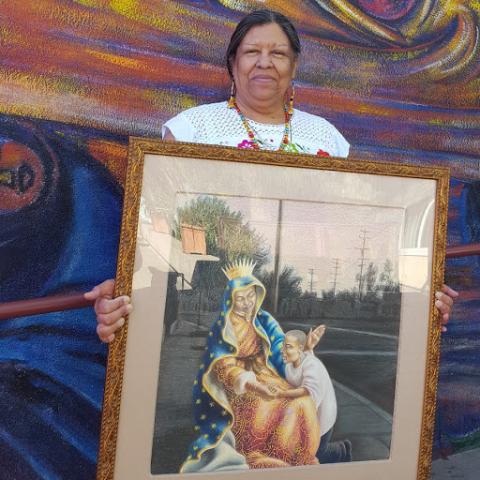
Rita Chairez (Dan Morris-Young)
Evaluations from participants tend to mirror those from the 21 men who took part in the self-awareness sessions in January at the California Institution for Men in Chino, a multi-facility prison with a total population approaching 5,000, several hundred of whom are serving life sentences.
Every man reported that he had been significantly moved by the stories of survivors, including that of Chairez, and brought to deeper appreciation of how their crimes injured others.
"It was interesting to see a victim who, in addition to being a victim of violence, shared her testimony to help us, and not to follow the path of violence," wrote one participant. "She showed us trust and kindness instead of hatred and resentment towards us who are here."
The workshop, wrote another, "impacted me because I was looking at this effect only toward my victim and I. Today, I know that I have also affected many more, for example the victim's relatives and also mine. Listening to the testimony of a victim has changed my way of thinking."
Chairez mentioned a session during which an inmate "stood up and said, 'When you see us, you see monsters.' I was shocked. This is how so many see themselves. I told him, 'Oh no, when I see you I see my brothers, not killers, not monsters.' "
"These men are not the crimes they did," Chairez said. "Many are really good brothers, sons, fathers who have gone to hell and back, and now they'd like to give back."
Advertisement
David (not his real name) is one of them, and today gives back through 40-60 hours weekly in the law profession.
While serving a six-year sentence, David took part in an extended, in-depth version of the restorative justice training titled Victim Offender Education Group, a two-year program that leads the incarcerated toward "understanding and developing insight into the underlying circumstances of their lives and the choices that led them to prison," according to its website.
"Specifically, the VOEG process recognizes that many incarcerated individuals have experienced unresolved traumatic events in their early lives which have contributed to their offending behaviors," the website continues. "The facilitators work to help identify and repair as much as possible the trauma by creating an environment of trust, safety, inclusiveness, acceptance and compassion, where issues of abuse, loss, thinking errors and transference can be acknowledged and addressed."
The training can be followed by an additional year's curriculum, titled "Next Step," graduates of which are called "Stewards" and are "encouraged to initiate ways of giving back to their prison community," states the group's literature.
Chairez helped facilitate much of David's work with the group. "The impact the program had on me was life changing," he emailed NCR. "There were 11 other men in my group and I would say that everyone was affected in the same way. I would also think that it would be almost impossible to not be changed by such a process."
David admits he felt he had "really grieved and experienced the emotions and feelings of my commitment offense," but "going through the exercises really led me to understand that I had no idea about the true impact and ripple effect that crime had on those involved directly and indirectly."
"To be honest," David said, "I was not looking for healing." He had heard restorative justice participation could potentially keep him in the same prison "which I wanted to do for the schooling that I was doing there."
But, he and 11 others were selected from about 50 inmates interviewed.
He described occasional ambivalence. "My only gripe was the way your actions in the past were sometimes hammered into you. But, then again, perhaps that was necessary for me to learn. With all the benefits of the program, that is fine. Like Rita said, we are going to heal the hurt by opening the scar."
David credits "Mama Rita" with "a significant portion of my recovery," and described her as "strong," "almost unbreakable" and "the real deal."
"I know her story and how she has been through a lot," he added. "She has helped others through very difficult situations. Not everyone is meant for that type of work. Rita has a heart the size of Texas. Her compassion, empathy and sympathy simply flow. And when you are around her, you can feel it. It's like an energy."
Like the men at Chino, David said his most heartrending experiences came in communicating with victims.
Near the program's conclusion "victims of similar crimes came in to have a multi-hour dialogue with us offenders," he explained. "I was very scared about this part, but this was the culmination of the program. A person came in to speak to me. Although this person wasn't the person affected by my crime, they had been affected by a similar crime. I was able to hear their side of the story and how the crime had affected them. Then they heard my story and my upbringing. The most powerful thing at the end of our dialogue was the person looked at me in the eyes and said, 'I forgive you.' They then gave me a hug. Very, very powerful stuff."
[Dan Morris-Young is NCR's West Coast correspondent. His email is dmyoung@ncronline.org.]





